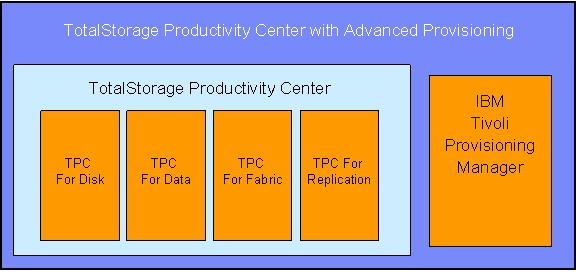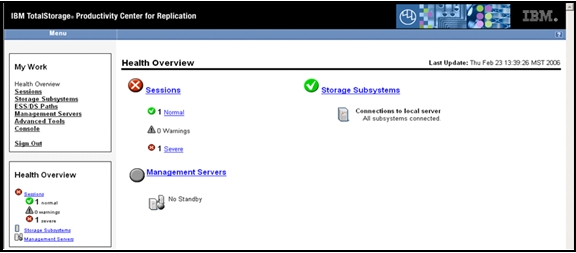| Tool Mentor: TPC – Execute IT Service Continuity Plan |
 |
|
| Related Elements |
|---|
ContextTool mentors explain how a tool can perform tasks, which are part of ITUP processes and activities. The tasks are listed as Related Elements in the Relationships section. You can see the details of how processes and activities are supported by this tool mentor, by clicking the links next to the icons: DetailsThe IBM® TotalStorage® Productivity Center (TPC) user interface allows storage administrators to launch IBM TotalStorage Open Software Family products. These products support the storage volume lifecycle, device configuration, performance, replication, storage network fabric, data backup, data availability, and data recovery, as well as enterprise policies. They also help in managing host, application, database, and file system data.
The TPC four main components are:
Data replication is the core function required for data protection and disaster recovery. It provides advanced copy services functions for supported storage subsystems in the SAN. The Replication Manager administers and configures the copy services functions and monitors the replication actions. Its capabilities consist of the management of two types of copy services: the continuous copy (also known as Peer-to-Peer, PPRC, or Remote Copy), and the point-in-time copy (also known as FlashCopy).
The job of the Replication Manager is to provide a single point of control for all replication activities. This role is filled by TPC for Replication. Given a set of source volumes to be replicated, the Replication Manager will find the appropriate targets, perform all of the configuration actions required, and ensure that the source and target volumes relationships are set up. If given a set of source volumes that represent an application, the Replication Manager will group these volumes in a consistency group, give that consistency group a name, and allow you to start replication on the application. Replication Manager will start up all replication pairs and monitor them to completion. If any of the replication pairs fail, meaning that the application is out of sync, the Replication Manager will suspend them until the problem is resolved, re-sync them, and resume the replication. The Replication Manager provides complete management of the replication process. TPC for Replication is designed to solve the many challenges with managing and utilizing point-in-time and continuous copy services. It is worth noting that these services are extremely valuable for enhancing business continuity, cloning applications for application testing, and other day-to-day activities. However, the fact that their implementation is generally unique to a given vendor and they are difficult to configure and use has prevented many customers from taking advantage of them.
For example, an IT manager might be interested in providing a continuous copy of a large application to a remote site.
For the administrator, simply identifying all the right source volumes and assigning them all to target volumes at the
remote site can be a daunting task.
For more informationFor more information about this tool, go to the IBM TotalStorage Productivity Center page. |
©Copyright IBM Corp. 2005, 2008. All Rights Reserved. |

